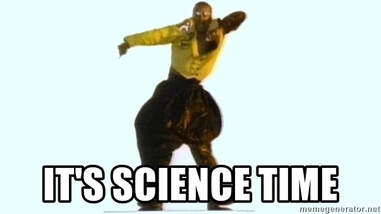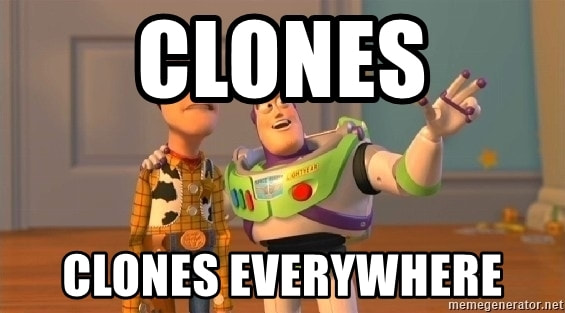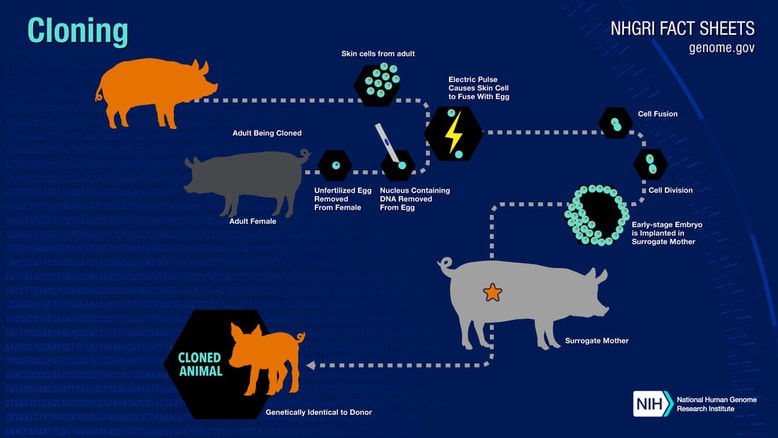Now Imagine this:
Jimmy is young man that has bad living habits. He constantly smokes, and ate lots of junk food. Unfortunately, one day, he got kidney disease. He takes many medicine, but it didn't work and his kidney disease kept getting worse. Finally, the doctor concludes that he needs a new kidney. A family member might be a close enough match that they could donate a kidney or you might get lucky and find an organ donor elsewhere. However, there is a chance that your body could reject the organ. Surprisingly, Jimmy is not worried. The hospital took a few of Jimmy's stem cells and cloned a new kidney for him, Jimmy is saved.
The story is made up(obviously), however, what happened in the story could very likely comes in to reality in the non-distant future due to continue advancement of cloning technology.
So, what is cloning?

Definition:
cloning describes a number of different processes that can be used to produce genetically identical copies of a biological entity. The copied material, which has the same genetic makeup as the original, is referred to as a clone.
How does cloning work?
In reproductive cloning, researchers remove a mature somatic cell, such as a skin cell, from an animal that they wish to copy. They then transfer the DNA of the donor animal's somatic cell into an egg cell, or oocyte, that has had its own DNA-containing nucleus removed. Heres the steps:
Step 1: Extract DNA from a donor. ...
Step 2: Prepare an egg cell. ...
Step 3: Insert somatic cell material. ...
Step 4: Convince the egg that it's fertilized and implant it. ...
Step 5: Repeat until viability.
cloning describes a number of different processes that can be used to produce genetically identical copies of a biological entity. The copied material, which has the same genetic makeup as the original, is referred to as a clone.
How does cloning work?
In reproductive cloning, researchers remove a mature somatic cell, such as a skin cell, from an animal that they wish to copy. They then transfer the DNA of the donor animal's somatic cell into an egg cell, or oocyte, that has had its own DNA-containing nucleus removed. Heres the steps:
Step 1: Extract DNA from a donor. ...
Step 2: Prepare an egg cell. ...
Step 3: Insert somatic cell material. ...
Step 4: Convince the egg that it's fertilized and implant it. ...
Step 5: Repeat until viability.
Some background information
The first study of cloning took place in 1885, when German scientist Hans Adolf Eduard Driesch began researching reproduction. In 1902, he was able to create a set of twin salamanders by dividing an embryo into two separate, viable embryos.
Dolly:
Dolly was cloned from a cell taken from the mammary gland of a six-year-old Finn Dorset sheep and an egg cell taken from a Scottish Blackface sheep. She was born to her Scottish Blackface surrogate mother on 5th July 1996. Dolly’s white face was one of the first signs that she was a clone because if she was genetically related to her surrogate mother, she would have had a black face.Dolly was important because she was the first mammal to be cloned from an adult cell. Her birth proved that specialised cells could be used to create an exact copy of the animal they came from.
Mixing genes:
Cloning increased people's understandings of DNA and genes, therefore many other experiments and/or technology started to derive from cloning. People started to wonder that if we can clone genes, perhaps we could mix them and create a new form a life? The answer turns out to be yes, scientist successfully created new organisms that had genes from 2 different species, for example, spider sheep. Those sheep are able to produce spier silk in their milk, pretty cool huh?
Dolly:
Dolly was cloned from a cell taken from the mammary gland of a six-year-old Finn Dorset sheep and an egg cell taken from a Scottish Blackface sheep. She was born to her Scottish Blackface surrogate mother on 5th July 1996. Dolly’s white face was one of the first signs that she was a clone because if she was genetically related to her surrogate mother, she would have had a black face.Dolly was important because she was the first mammal to be cloned from an adult cell. Her birth proved that specialised cells could be used to create an exact copy of the animal they came from.
Mixing genes:
Cloning increased people's understandings of DNA and genes, therefore many other experiments and/or technology started to derive from cloning. People started to wonder that if we can clone genes, perhaps we could mix them and create a new form a life? The answer turns out to be yes, scientist successfully created new organisms that had genes from 2 different species, for example, spider sheep. Those sheep are able to produce spier silk in their milk, pretty cool huh?
Criticisms regarding Cloning
What are some negative effects of cloning?
Researchers have observed some adverse health effects in sheep and other mammals that have been cloned. These include an increase in birth size and a variety of defects in vital organs, such as the liver, brain and heart. Other consequences include premature aging and problems with the immune system.
Opposition of cloning:
The negative effect of cloning explains why cloning faced major opposition, especially when it involves the cloning of a human. The process of cloning itself causes animal suffering and the animals with the highest economic value are prone to developing severe health problems – pushed to their physical limits, they are condemned to a lifetime of suffering. If a human is cloned, the clone would have self-conscious and emotions, cloning human was therefore considered inhumane. In America, Arkansas, Iowa, Michigan, and North Dakota — prohibit both reproductive and therapeutic cloning, while three states — California, Louisiana, and Rhode Island — ban reproductive cloning but permit therapeutic cloning.
Researchers have observed some adverse health effects in sheep and other mammals that have been cloned. These include an increase in birth size and a variety of defects in vital organs, such as the liver, brain and heart. Other consequences include premature aging and problems with the immune system.
Opposition of cloning:
The negative effect of cloning explains why cloning faced major opposition, especially when it involves the cloning of a human. The process of cloning itself causes animal suffering and the animals with the highest economic value are prone to developing severe health problems – pushed to their physical limits, they are condemned to a lifetime of suffering. If a human is cloned, the clone would have self-conscious and emotions, cloning human was therefore considered inhumane. In America, Arkansas, Iowa, Michigan, and North Dakota — prohibit both reproductive and therapeutic cloning, while three states — California, Louisiana, and Rhode Island — ban reproductive cloning but permit therapeutic cloning.
The future of cloning

Live births have been achieved using somatic nuclear transfer in mice, sheep, cows and goats, and the technique would probably also be successful in humans. However, the low efficiency of the procedure may restrict its immediate application to the production of small herds of identical animals. Thus cloning technology is unlikely to be used to clone an entire organism.
Despite the fact that many aspect of cloning cannot be used, the future of cloning is still looking bright. It will most likely be used in medical fields: the use of somatic-cell nuclear transfer to generate replacement tissues or organs. This would avoid the risks of tissue rejection by supplying a person with new tissue of exactly their own genetic type. If this is eventually achieved, our medical condition will be raised to the next level. For those who are interested in medical, cloning may even be part of your job! Sounds pretty interesting.
References:
https://www.nature.com/articles/45429
https://www.genome.gov/about-genomics/fact-sheets/Cloning-Fact-Sheet
https://dolly.roslin.ed.ac.uk/facts/the-life-of-dolly/index.html
https://www.nature.com/articles/45429
https://www.genome.gov/about-genomics/fact-sheets/Cloning-Fact-Sheet
https://dolly.roslin.ed.ac.uk/facts/the-life-of-dolly/index.html



